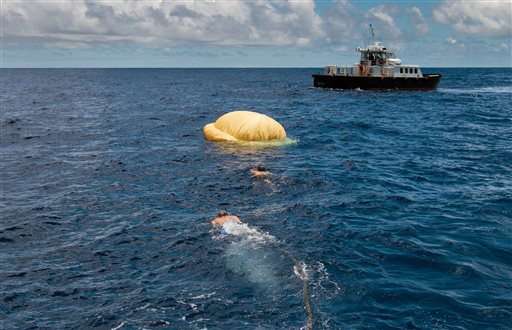 Two members of the Navy's Explosive Ordinance Disposal team swim towards the pilot ballute (a combination balloon and parachute used for braking at high altitudes and speeds) that was used to deploy the parachute for the test of NASA's Low-Density Supersonic Decelerator, off the coast of the U.S. Navy's Pacific Missile Range Facility in Kauai, Hawaii, in this June 28, 2014, photo provided by NASA.
Two members of the Navy's Explosive Ordinance Disposal team swim towards the pilot ballute (a combination balloon and parachute used for braking at high altitudes and speeds) that was used to deploy the parachute for the test of NASA's Low-Density Supersonic Decelerator, off the coast of the U.S. Navy's Pacific Missile Range Facility in Kauai, Hawaii, in this June 28, 2014, photo provided by NASA.LOS ANGELES - NASA engineers insisted Friday that a test of a vehicle they hope to one day use on Mars achieved most of its objectives, despite a parachute that virtually disintegrated the moment it deployed.
The engineers laid out at a news conference what they've learned in the six weeks since the $150 million high-altitude test of a vehicle that's designed to bring spacecraft - and eventually astronauts - safely to Mars.
Engineers said they achieved the main objective: getting a flying saucer-shaped craft to 190,000 feet above the Earth at more than four times the speed of sound under test conditions that matched the Martian atmosphere.
"The vehicle did an amazing job of getting to the right speed and altitude," said Ian Clark, principal investigator at NASA's Jet Propulsion Laboratory.
As the craft prepared to fall back to Earth, a doughnut-shaped tube around it expanded like a Hawaiian puffer fish, creating atmospheric drag to dramatically slow it down from Mach 4.3, a task that weeks of analysis have shown it performed beautifully, NASA said.
"At this point, we've actually achieved most of the objectives of the flight we've had for this summer," Mark Adler, the project manager, said of the first of three tests for the vehicle.
In the two other experiments planned for next year, NASA will try to figure out how to properly deploy the parachute, which immediately tore and tangled when it was let out, showing that engineers have "more to learn," Clark said.
"The idea of taking 200 pounds of Kevlar and nylon and deploying it at 2,500 mph, 200 pounds that inflated would be the size of a small warehouse, is certainly a challenging endeavor. There's a lot of physics with this problem that we're now gaining new insights into that we've never had before," Clark said. "And we're going to take all of that knowledge, and feed it toward our flights next year."
